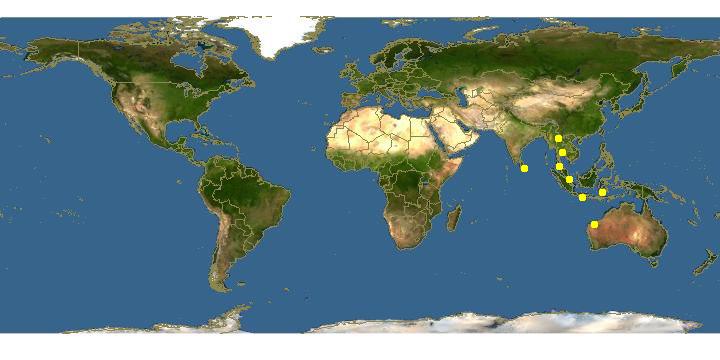The book our stolen future brought world-wide attention to scientific discoveries about a facts that common contaminants can interfere with organism developments, especially endocrine disruption. At sea, toxic chemicals is one of the most dangerous disturbance to marine population. Do you still remember minamata tragedy? Aside from hundreds of human, all of fishes were also died and floated because of dramatic increase of mercury’s poison at Minamata Bay, 1956.
At this time, the scientist are monitoring water environment to control the toxic pollution at coastal marine environment. Physical and chemical parameters were measured, and medaka fish was also used to examine the pollution degree & its bioavailability.
Medaka (Oryzias sp.) are actinopterygii or ray-finned fish with the average body length were 3 cm. This genus comprises more than 14 species, with the java medaka (O. javanicus-Bleeker, 1854) is the most highly adaptable to different salinity (can live in fresh water, brackish water, as well as salt water) among other Oryzias species. On meristic experiments, the number of dorsal fin were 6-7, anal fin 20-25 and caudal fin were 5-6. They eat artemia, insects, tubifex worms and protozoa.

Java Medaka are widely distributed in Asia, especially in Indonesia, Malaysia and Thailand and live in well defined habitat. They have a unique osmotic adaptation mechanism (enhances the capacity of Na+ and Cl− secretion in ionocytes and hypoosmoregulatory ability while exist in seawater). They live long-enough with short generation time (2-3 months, make them possible to obtain five generations a year) and available at all periods of the year. Medaka are also highly adaptable fish and stable in laboratory aquaculture. These create medaka as important fishes to monitor the pollution threat in the ocean.
Woo et al (2014) suggest that there is transcriptional changes caused by Bisphenol A (BPA) in java medaka. 533 genes of seawater, 215 genes of freshwater and 78 shared genes were changed significally their expression, which mainly involved in cellular and signaling pathway. These finding were also revealed the alteration of salinity as one of environmental stressor can potentially affect the toxicity, since transcriptional changes was also regulated differently under environmental salinity.
In addition, the induction of metallothionein (MT) chemical substance on juvenile java medaka are statistically significant with positive correlation with the cadmium level (Cd) in their tissues.
Another study of low level Cd exposure (0.01-0.10 ppm) resulted in several development impairments to java medaka egg. Nevertheless, this impairment was significantly observed to eggs on low levels mercury (Hg), 0.01-0.02 ppm. Lower concentration of Hg were found to cause teratogenesis on java medaka. Although java medaka eggs successfully hatched 375.7 to 78.6% when exposed on high concentration of Hg, this fish is more sensitive to Cd exposure within the same concentration (successful rate 0-52.5%) (Ismail and Yusof, 2011).
As biological effect monitoring, Estrogenic chemicals (EI) and 17β-estradiol (E2) are a natural steroid hormone, detected in sewage treatment works effluents and estuarine water. They were known to cause induction of vitellogenin, the appearance of testis-ova in male fish and lead to endocrine disruption. Fortunately, based on Imai et al (2007) research, at very low concentration, 39-198 ng/L, java medaka will not be affected to these chemicals.
We expect that such continuous experimental is needed to understand the genetic variation and modification of java medaka after toxicology exposure, especially on offspring impact. The application of experimental techniques to this fish would bring us new information to understand how medaka has developed diverse mechanisms to adapt in diverse environments as well.
References:
Colborn T, Dumanoski D, Myers JP. 1996. Our stolen future: Recent important scientific studies. http://www.ourstolenfuture.org/. Accessed on October 2017.
Fishbase. Oryzias javanicus. http://www.fishbase.org/summary/12254. Accessed on October 2017.
Imai S, Koyama J, Fuji K. 2007. Effects of estrone on full life cycle of java medaka (Oryzias javanicus), a new marine test fish. Environ Toxicol Chem. 26 (4): 726-731.
Ismail A., Yusof S. 2011. Effect of mercury and cadmium on early life stages of Java medaka (Oryzias javanicus): A potential tropical test fish. Marine Poll Bull. 63: 347-349.
Khododaust D, Ahmad I. 2013. Metallothionein-like protein levels in java medaka fish (Oryzias javanicus) exposed to different concentration of cadmium. Walailak J Sci & Tech. 11(10): 883-893.
Kudo A, Fujikawa Y, Miyahara S, Zheng J, Takigami H, Sugahara M, Muramatsu T. 1998. Lessons from minamata mercury pollution, Japan—After a continuous 22 years of observation. Wat Sci Tech. 38(7): 187-193.
Miyanishi H, Inokuchi M, Nobata S, Kaneko T. 2016. Past seawater experience enhances seawater adaptability in medaka, Oryzias latipes. Zoological Lett. 2(12): 1-10.
Woo S, Denis V, Yum S. 2014. Transcriptional changes caused by bisphenol A in Oryzias javanicus, a fish species highly adaptable to environmental salinity. Mar drugs. 12: 983-998.
First picture: http://3.bp.blogspot.com/_58yBWvhQZ-g/Sid2jPsNWaI/AAAAAAAAAEA/E0Xz78PVIqI/s1600/oryzias%252520javanicus%252520m-5
Second picture: http://www.discoverlife.org/nh/maps/Vertebrata/Fish/Adrianichthyidae/Oryzias/map_of_Oryzias_javanicus
